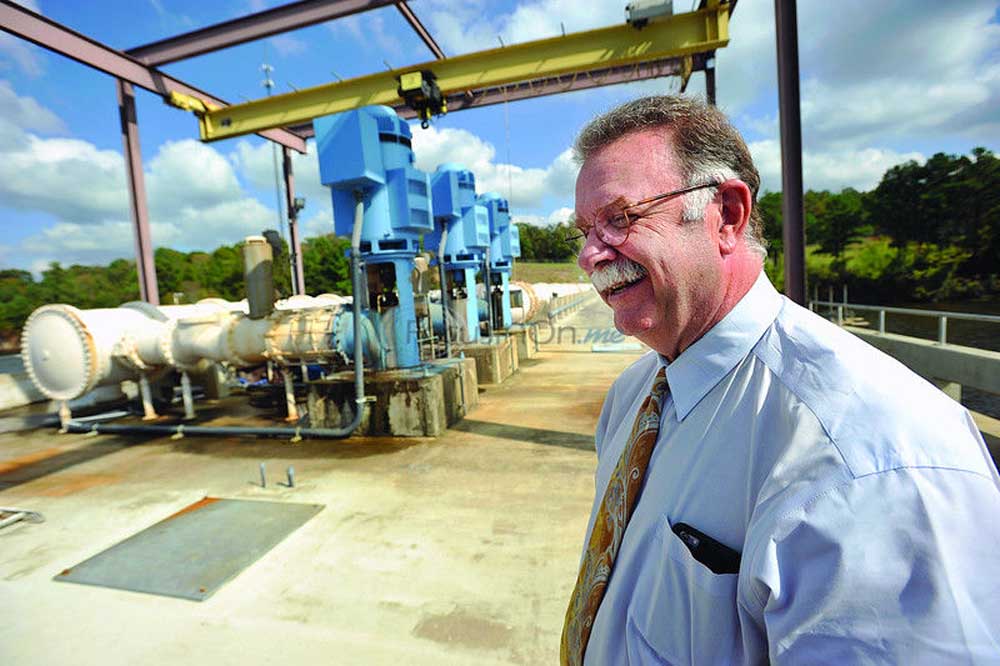Tyler Water utilities customers receive second notice on chemical byproducts
Published 6:58 pm Monday, January 25, 2016

- Greg Morgan, city of Tyler director of utilities and public works, talks about the water system Wednesday near the pump station at Lake Palestine southwest of Tyler. From here, lake water travels through miles of five-foot diameter pipe to a city water treatment facility and, as quickly as some 20 hours later, from faucets at homes and business around the community, ready and safe to drink. Andrew D. Brosig/Tyler Morning Telegraph
This month’s water bill comes with some added reading material – a glossy four-page color pamphlet explaining recent issues with the city’s water supply and assuring residents the water is safe.
The notice details how the municipal water supply recently exceeded the acceptable level of disinfectant byproducts. The elevated readings were expected by city officials because of the state-mandated testing methodology for the byproducts, also known as haloacetic acids, which are created during the water disinfection process when chlorine reacts with organic matter in the water.
“The water in Tyler remains safe for our customers to use,” Tyler Water Utilities Water Director Greg Morgan said Monday. “We are continually monitoring the water quality and the water remains safe for our customers.”
This is the second notice customers have received about elevated levels of byproducts. The first came in October, after city’s water supply initially tested above regulated levels.
The Environmental Protection Agency caps the acceptable level of the byproducts at 60 parts per billion. A third-party company completes tests at eight individual sites quarterly. Each site’s level of byproducts then is averaged with the three previous scores – that average of four scores must be below 60 parts per billion to meet federal and state standards for each site.
For the final quarter of 2015, the city’s water tested between 61 and 75 parts per billion at the eight test sites, according to this month’s mailed notice.
Those numbers are down from the tests the previous quarter. The peak level reported in that period was 126 parts per billion. Because the results are based on a rolling average of four testing periods, Morgan said the city expects to be above the threshold for the first quarter of 2016, after which the highest score will roll off and will no longer be factored into the average.
Morgan said the city believes the initial influx of byproducts happened as a result of heavy spring rains, which washed dirt and other organic matter into the lakes from which the city draws its water.
Long-term exposure to high levels of the chemicals over multiple decades has possible links to certain types of cancer, notably bladder cancer, according to the Texas Commission on Environmental Quality.
NOTIFICATION METHOD
Following immense public interest, due in part to Facebook posts from water activist Erin Brockovich, the city changed its notification method to include more information. In October, the city sent out only the required verbiage as required by the TCEQ.
This month’s notice is in a pamphlet form, and includes information on the byproducts themselves as well as the disinfection process used to clean the city’s drinking water. It also includes a map of the testing sites and a list of numbers to call with concerns or problems.
Morgan said Tyler modeled the pamphlet after the city of Kerrville.
“We got a lot of questions, we got a lot of concerns and a lot of people seeking more information,” Morgan said. “This allows us to answer those questions, so the customers can better understand the notice.”
Morgan said the pamphlets are on better paper, but the city is saving costs by sending it with water bills instead of as a standalone notice. Mailing the October notice cost more than $17,000 in postage and printing, he said.
INDEPENDENT STUDY
Tyler commissioned an independent analysis of its drinking water sanitation practices in November after Brockovich criticized the city multiple times on her Facebook page.
The city commissioned Enprotec/Hibbs & Todd Inc. to look at how to improve its water sanitation practices and reduce the amount of byproducts created.
The company presented areas where the city could improve its practices, but said the city’s problem is common among all water systems. Enprotec presented long and short-term recommendations to minimize the production of chlorine byproducts.
The short-term recommendations were to be accomplished within the current budget cycle with minimal expense to get the byproduct creation under regulatory standards. Long-term solutions were intended to push production levels well below the standard but required capital investment to accomplish.
Twitter: @TMTFaith






